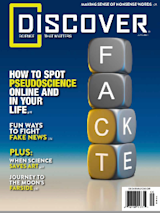This article appeared in the June 2021 issue of Discover magazine as "Tales From the Fringe." Subscribe for more stories like these.
Imagine a universe rife with cosmic catastrophes: Jupiter ejecting a comet into space that would later become the planet Venus. The comet whizzing past Earth and changing its rotation. The resulting chaos on Earth causing natural disasters of biblical proportions — literally — like the parting of the Red Sea. In the mid-1900s, Immanuel Velikovsky, a psychiatrist and author, claimed that he could prove these radical ideas.
Velikovsky laid out his case in Worlds in Collision, a 1950 bestseller. But the book wasn’t billed as creative fiction or a fanciful hypothesis based on anecdotal accounts of the past; rather, Velikovsky presented these interplanetary theories, and others, as factual.
Many scientists didn’t buy it. “That this is a remarkable story no one — proponents and opponents alike — will ...















